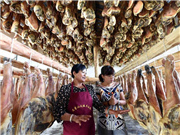

3) Regional development became more balanced.
We accelerated the implementation of the “Three Major Strategies”: the Silk Road Economic Belt and 21st Century Maritime Silk Road (“One Belt and One Road” strategy); the coordinated development of the Beijing-Tianjin-Hebei region; and the development of the Yangtze River economic belt. We finalized plans for advancing the “One Belt and One Road” strategy, steadily launching pragmatic cooperation in a wide range of areas. We completed the functional zoning of the Beijing-Tianjin-Hebei region and established the plan for its coordinated development, and made initial breakthroughs in three key areas of integrated transportation, environmental protection, and industrial upgrading and relocating. We issued and implemented guidelines on stimulating the development of the Yangtze River economic belt, which revolve around making use of the Yangtze’s role as a golden waterway, and launched the plan to build an integrated multidimensional transportation corridor along the Yangtze River economic belt. A total of 33 key projects for the large-scale development of China’s western region were launched, representing a total investment of 835.3 billion yuan; and a list of industries encouraged for development in the western region was released and put into effect. Guidelines concerning a number of major policies and measures to support the revitalization of northeast China in the near future were issued, and progress was made in the transformation of cities once dependent on resources that are now depleted. Continued efforts were made to establish the central region as a national integrated transport hub and as a center for production of grain, energy, and raw materials, and the development of modern equipment manufacturing and high-tech industries. The regions’ developmental layout consisting of two east-west and two north-south economic belts was further improved. The economic transformation of the eastern region gained momentum, and continued to spur on the development of the Chinese economy. Increased economic support was provided for old revolutionary base areas, ethnic minority areas, border areas, poor areas, and especially contiguous areas with acute difficulties.
5. We stepped up efforts to conserve energy, reduce emissions, and protect ecosystems and the environment, making the most significant progress in this regard since the beginning of the Twelfth Five-Year Plan.
We continued to lay emphasis on energy conservation and emissions reduction as priority initiatives in changing the growth model and making structural adjustments. Our policies in this regard began to yield greater cumulative effects.
1) Remarkable results were achieved in energy conservation and emissions reduction.
We reduced energy intensity and controlled the increase in total energy consumption. The share of non-fossil fuels in primary energy consumption reached 11.2%, up 1.1 percentage points over the previous year; energy consumption and carbon dioxide emissions per unit of GDP dropped by 4.8% and 6.2% respectively; and emissions of sulfur dioxide, chemical oxygen demand, ammonia nitrogen, and nitrogen oxides declined by 3.4%, 2.47%, 2.9%, and 6.7%, respectively. Efforts to meet the energy conservation and emissions reduction targets of the Twelfth Five-Year Plan made progress on schedule.
2) Good progress was made in ecological and environmental protection.
We made new strides in preventing and controlling air, water, and soil pollution. We vigorously carried out a series of major projects aimed at controlling pollution in key drainage basins, demonstrating the application of denitrification technologies in facilities other than power plants, and controlling air pollution in the Beijing-Tianjin-Hebei region and adjacent areas; and further improved mechanisms for regional coordination of pollution prevention and control. We accelerated the comprehensive prevention and control of pollution from motor vehicles. The percentages of urban sewage treated and household waste safely disposed reached 90.15% and 90.3% respectively. Water consumption per 10,000 yuan of value-added by industry totaled 63.5 cubic meters, dropping by 5.6%. We made enhanced efforts to protect and restore major ecosystems such as wetlands, forests, grasslands, and areas of biological diversity and richness; and continued to carry out ecological projects to convert marginal farmland back to forest, turn grazing land back into grassland, protect virgin forests, and build key forest shelterbelts. A total of 6.027 million hectares of land were afforested.
3) Further progress was made in responding to climate change.
We promulgated the National Plan for Responding to Climate Change (2014-2020), and issued the China-U.S. Joint Announcement on Climate Change, stating that China aims to achieve the peaking of carbon dioxide emissions around 2030 and to increase the share of non-fossil fuels in primary energy consumption to around 20% by 2030. We intensively carried out pilot projects to encourage low-carbon growth in provinces, regions, cities, and industrial parks; and made steady progress in developing a market for the trading of carbon emission rights.
 |  |
Day|Week

 Tsinghua junior makes over 10,000 yuan a day by selling alumnae's used quilts
Tsinghua junior makes over 10,000 yuan a day by selling alumnae's used quilts Graduation photos of students from Zhongnan University
Graduation photos of students from Zhongnan University A school with only one teacher in deep mountains
A school with only one teacher in deep mountains Glimpse of cultural heritage "Xilankapu"
Glimpse of cultural heritage "Xilankapu" Homemade cured hams in SW China
Homemade cured hams in SW China Breathtaking buildings of W. Sichuan Plateau
Breathtaking buildings of W. Sichuan Plateau Graduation photos of "legal beauties"
Graduation photos of "legal beauties" Top 10 most expensive restaurants in Beijing in 2015
Top 10 most expensive restaurants in Beijing in 2015